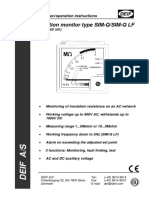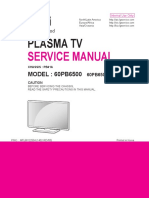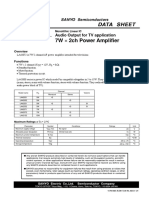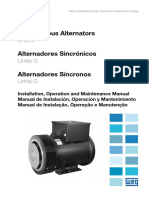How To Make SMPS Pass Surge & Lightning Test
How To Make SMPS Pass Surge & Lightning Test
Uploaded by
dcasdcasdcasdcCopyright:
Available Formats
How To Make SMPS Pass Surge & Lightning Test
How To Make SMPS Pass Surge & Lightning Test
Uploaded by
dcasdcasdcasdcOriginal Title
Copyright
Available Formats
Share this document
Did you find this document useful?
Is this content inappropriate?
Copyright:
Available Formats
How To Make SMPS Pass Surge & Lightning Test
How To Make SMPS Pass Surge & Lightning Test
Uploaded by
dcasdcasdcasdcCopyright:
Available Formats
Application Note, V1.
0, September 2006
How to design SMPS to Pass Common Mode Lightning Surge Test
Power Management & Supply
N e v e r
s t o p
t h i n k i n g .
Edition 2006-09-06 Published by Infineon Technologies Asia Pacific, 168 Kallang Way, 349253 Singapore, Singapore Infineon Technologies AP 2004. All Rights Reserved. Attention please! The information herein is given to describe certain components and shall not be considered as a guarantee of characteristics. Terms of delivery and rights to technical change reserved. We hereby disclaim any and all warranties, including but not limited to warranties of non-infringement, regarding circuits, descriptions and charts stated herein. Information For further information on technology, delivery terms and conditions and prices please contact your nearest Infineon Technologies Office (www.infineon.com). Warnings Due to technical requirements components may contain dangerous substances. For information on the types in question please contact your nearest Infineon Technologies Office. Infineon Technologies Components may only be used in life-support devices or systems with the express written approval of Infineon Technologies, if a failure of such components can reasonably be expected to cause the failure of that life-support device or system, or to affect the safety or effectiveness of that device or system. Life support devices or systems are intended to be implanted in the human body, or to support and/or maintain and sustain and/or protect human life. If they fail, it is reasonable to assume that the health of the user or other persons may be endangered.
Revision History: Previous Version: Page
2006-09 none Subjects (major changes since last revision)
V1.0
How to Design SMPS to Pass Common Mode Lightning Surge Test: License to Infineon Technologies Asia Pacific Pte Ltd Luo Junyang Kok Siu Kam He Yi Jeoh Meng Kiat
AN-PS0001
We Listen to Your Comments Any information within this document that you feel is wrong, unclear or missing at all? Your feedback will help us to continuously improve the quality of this document. Please send your proposal (including a reference to this document) to: ap-lab.admin@infineon.com
Table of Contents 1 2 3 4 5 5.1 5.2 5.3 5.3.1 5.3.2 5.4 5.4.1 5.4.2 6
Page
Introduction.................................................................................................................................5 Overview of Lightning Surge Test Standards ..........................................................................5 Test Set-up ..................................................................................................................................6 How is IC interferenced by lightning surge voltage.................................................................7 SMPS Design consideration under lightning surge Test.........................................................8 PCB primary GND design .............................................................................................................8 Y capacitor between primary GND and secondary GND (Earth)...................................................9 Transformer design.......................................................................................................................9 Insulation voltage..........................................................................................................................9 Transformer shielding ...................................................................................................................9 Others...........................................................................................................................................9 Pin filtering capacitor ..................................................................................................................10 High voltage pin for startup cell...................................................................................................10 Summary ...................................................................................................................................10
Application Note
2006-09-06
Introduction
Lightning surge is the most common source of overstresses. Overstresses in the form of overvoltage and overcurrent can happen in consumer equipments which contain tuner receiver like TV set, recordable DVD player etc, as it is exposed to the lightning strikes through the antenna and the AC line. Consumer equipment makers in general perform lightning surge test on their products before going into volume production. It is to ensure that the equipment can not be interrupted during operation or even damaged by the lightning surge. This application note is intended to advise the designer of switched mode power supply (SMPS) circuit in consumer equipments on how to properly design SMPS to avoid the disruptive influence and the damaging effect of the overstress by the lightning.
Overview of Lightning Surge Test Standards
Currently prevailing standards for the lightning surge test are the European standard IEC61000-4-5 and the Japanese standard JEC210/212. Table 1 shows the differences between the two standards. Ref. Standard Test Voltage Pulse Waveform & output impedance Z JEC210/212 7kV or special Open-circuit output voltage characteristic : Surge voltage waveform : 1.2/50 s Output impedance, Z : not defined; some equipments use 6 If the surge voltage is 30kV, it can generate 5kA short-circuit current (30kV/6). Short-circuit output current characteristics : Surge current waveform : 8/20s ( refer to fig. 1 ) Output impedance, Z : not defined; some equipments use 5 If the required surge current is 6kA, it needs to generate 30kV output voltage (6kA x 5). Not defined. IEC61000-4-5 0.5, 1, 2, 4kV or special Open-circuit output voltage characteristic : Surge voltage waveform : 1.2/50 s Output impedance, Z : 2 If the surge voltage is 15kV, it can generate 7.5kA short-circuit current (15kV/2).
Short-circuit output current characteristics : Surge current waveform : 8/20s ( refer to fig.1 ) Output impedance, Z : 2 If the required surge current is 7.5kA, it needs to generate 15kV output voltage (7.5kA x 2). Differential mode : 18uF Common mode : 10 + 9F
Coupling to AC Lines (Power testing) Table 1
JEC standard vs IEC standard
The lightning testing current wave shape is defined in Figure 1. For an 8x20s waveform, T1 = 8s and T2 = 20s. In general, surge voltage of 2kV up to 16kV, with increasing step of 2kV, is applied across AC line as well as across one of the AC line and the chassis ground of the equipment under test (EUT), ie. L-N, L-G and N-G. The SMPS in the EUT, which is directly exposed to the surge power, must be undamaged and continue to operate properly after the surge is applied. Most of the equipment makers used JEC210/212 standard until early 1990 when IEC61000-4-5 was implemented. The IEC standard since then becomes very common.
Application Note
2006-09-06
Figure 1
Lightning Pulse Waveform
Test Set-up
Figure 2 shows the complete lightning surge test setup. The LCD TV with the external SMPS adapter is used as the EUT. The lightning surge generator is an ideal voltage source with the specified waveform which is connected to its output ports with the known fixed resistance as in Table 1. It as well as the SMPS adapter gets the AC power from the isolation transformer. For the differential surge test, the surge voltage is applied across the AC lines of the SMPS adapter, whereas for the common mode surge test, it is applied across one of the AC line and the equipments ground connection at the tuners input socket of the TV-set. The number of strikes is 5 at each voltage step (2kV to 16kV) and at each polarity.
Lightning Surge Ge nerator
AC Source
Vo L
DC-DC Converte r
N Tuner
Isolation Transformer
E xternal SMPS Adapter LCD TV
E UT
Figure 2
Lightning Surge Test Connections
Chassis ground
Application Note
2006-09-06
How is IC interferenced by lightning surge voltage
I4
I1 I2
I3
Figure 3
Circuit example of the SMPS under Test
Figure 3 shows a circuit example which is under lightning surge test. The circuit is a flyback converter with CoolSET-F3 PWM controller. The surge signal is across between neutral and earth ground. Possible surge current paths, I1, I2 and I3 are shown in the diagram. I1 is the current which is passing through safety Y capacitor CY1 between Neutral and Earth. In general I1 is limited before bridge rectifier and not observed by PWM IC. I2 is the current which is passing through EMI capacitor C4, and I3 is the current which is passing through transformer from secondary GND (earth) to primary GND. I2 and I3 may influence IC GND potential depending on PCB design as shown in Figure 4. I4 is the current which is also passing through transformer but from secondary GND (earth) to primary bulk positive. I4 will influence IC as well if IC has the pins to directly connecting to high voltage bulk positive.
I2+I3
Figure 4 Surge current on the IC GND
Assuming Z is the impedance of PCB track in pink colour, then the voltage across IC pin 1 (Softs) and Pin 8 (GND) is:
VSofts _ GND = VC 7 + Z ( I 2 + I 3 )
(1)
Where, VC7 is voltage across soft start capacitor C7. it can be considered as constant voltage during lightning surge. From equation (1), it can be seen that IC observes a noisy voltage caused by I2 and I3. The similar effect also occurs on the IC Pin voltage of FB to GND, Vcc to GND and Isense to GND. Depending on how Application Note 7 2006-09-06
high the noisy voltage become, IC may enter into fault condition such as protection mode or even be damaged.
5
5.1
SMPS Design consideration under lightning surge Test
PCB primary GND design
From the section 4, it can be seen that IC pins may observe the noisy signal which are highly dependent on PCB design. So the guideline for PCB design is to divert I2 and I3 to other path which is not observed by IC. Star connection is highly recommended for the following GND which have to be separated and connected together in bulk capacitor negative pin as shown in Figure 5.
small signal IC GND, high current CS GND, input bridge rectifier GND, MOSFET Heatsink Y capacitor GND (if Y capacitor is connected between transformer primary GND and secondary GND Transformer auxiliary winding GND
I1 I2
I3
Figure 5
Star connection for primary GND
With the properly star connection as in Figure 5, I2 and I3 will not pass through the PCB track in green colour and IC voltage between pins will not observe noisy signal any more. Although the above star connection is preferred for lightning surge immunity, some GND tracks ares not able to apply this rule due to other concern. One example is transformer auxiliary winding GND in the case of ICEXQS01 Quasi-resonant flyback controller. In this Quasi-resonant controller, auxiliary winding is not only for IC Vcc supply but also to sense minimum MOSFET drain-source voltage for Quasi-resonant operation (and also call zero crossing sensing). In some cases auxiliary winding GND has to connect directly to IC GND pin due to too low signal to noise ratio during normal operation, and then I3 can not be avoided to Application Note 8 2006-09-06
influence the IC Pins during lightning. In such circumstance, one way to improve lightning noise immunity is to design the PCB track for auxiliary winding GND as thick as possible, in order to have low impedance Z.
5.2
Y capacitor between primary GND and secondary GND (Earth)
The function of the Y capacitor C4 in Figure 5 is to bypass EMI noise. Instead of primary ground, sometimes C4 can be connected to bulk capacitor positive pin for the same EMI purpose. With doing that, lightning surge current I2 is diverted to bulk positive and will not influence IC GND any more. However, if this is not possible due to other concern and C4 has to be connected to primary GND, the above star connection has to be applied.
5.3
Transformer design
Insulation voltage
5.3.1
I3 current amplitude is dependant on transformer insulation. If transformer insulation is lower than lightning surge voltage, short time breakdown between primary and secondary will occur and very high surge current will be generated. Besides that IC is interferenced by such high surge current, secondary rectifier diode will also experience high voltage stress during short breakdown time and be damaged. So transformer insulation voltage is suggested to be higher than lightning test voltage.
5.3.2
Transformer shielding
Transformer shielding may also help to reduce the parasitic capacitance between primary and secondary. One example is shown in Figure 6 which is from a multiple outputs SMPS design.
Pin 7
Primary
Pin 8&9 Pin 4 Pin 2&3
4 turns 2xAWG#28 Aux. 11 turns 2xAWG#28 Prim.
Pin 12&13
Aux. winding is placed outside most of the transformer to decrease coupling between Aux winding and secondary winding.
Pin 10&11 Pin 16
3 turns 2xAWG#28 Sec.3
Secondary
8 turns 2xAWG#28 Sec.2 27 turns 1xAWG#28 Sec.1
Pin 1 Pin 2&3 Pin 1
Pin 14 Pin 18 Pin 17
Primary
40 turns 1xAWG#28 Prim. 11 turns 2xAWG#28 Prim.
A shielding winding which is connected to Bulk positive is added to divert surge current via Bulk positive, instead of GND.
Core Center Limb
Margin tape 3mm Margin tape 3mm
Figure 6
transformer winding design with shielding layer
In Figure 6, the shielding layer is inserted between primary and secondary and connected to bulk capacitor positive. Because shielding layer is much closer to secondary side, the parasitic capacitance between secondary GND to shielding layer is higher compared to secondary GND to Auxiliary winding. So during lightning surge test, the surge current is more likely via shielding layer going into bulk positive instead of primary GND which may influence IC GND.
5.4
Others
Application Note
2006-09-06
5.4.1
Pin filtering capacitor
Most of IC pins has a filtering capacitor to reject the RF noise caused by lightning surge. This capacitor should be also located as close as possible to IC pin for better performance.
5.4.2
High voltage pin for startup cell
Some ICs such as ICE3A(B)S02 which have startup cell integrated. As the shown in Figure 3, the lightning surge current may also go through bulk capacitor positive. If the startup cell pin is directly connected to positive directly, the lightning noise will be radiated as transmitter from the PCB track which is connected startup cell with bulk capacitor positive. So it is necessary to keep this track as thin as possible and enough clearance from other small signal tracks. If it is not possible, a 100k resistor can be connected between bulk capacitor positive and startup cell pin.
Summary
To design SMPS with lightning surge immunity, the following items have to be
Grounding - star connections must be applied - AUX GND, signal GND use separate tracks to IC GND - IC GND, Current sense resistor GND, Bridge Rectifier GND, MOSFET heatsink GND, and
Y1 capacitor GND (if Y1 connected to primary GND) use separate tracks and connect together at Bulk Cap negative.
Y1 Capacitor - Y1 cap can be connected to bulk capacitor positive instead of primary GND if possible. Transformer structure - High insulation voltage - Aux winding can be placed at the outmost of the transformer for better performance - Shielding winding can also be added for better performance Others - The filter capacitor should be across IC Pin and IC GND Pin as near as possible. - HV pin tracks should be thinner and it must be placed far from other signal tracks.
References
[1] [2] [3] [4] Infineon Technologies, Datasheet, ICE3AS02 / ICE3BS02 Off-Line SMPS Current Mode Controller with Integrated 500V Startup Cell, May 21 2004, Infineon Technologies, Application Note, ICE3BS02 Off-Line SMPS Current Mode Controller with Integrated 500V Startup Cell, April 2004 NoiseKen, Specifications, Lightning Surge Simulator Infineon Technologies, Application Note, ICE3BS02 Designing SMPS Adapter using ICE3BS02 to Pass Common Mode Lightning Surge Test, June 2005
Application Note
10
2006-09-06
You might also like
- Breaksafe Series 5000 Wiring DiagramDocument1 pageBreaksafe Series 5000 Wiring DiagramLeeGeddesNo ratings yet
- Introduction to Power System ProtectionFrom EverandIntroduction to Power System ProtectionRating: 4 out of 5 stars4/5 (2)
- Catalog SurgelogicDocument14 pagesCatalog SurgelogicLuizNo ratings yet
- An Evalsf3 Ice3b0565Document17 pagesAn Evalsf3 Ice3b0565Alecsandru NitaNo ratings yet
- Panasonic GLP23A Chasis SchematicsDocument39 pagesPanasonic GLP23A Chasis SchematicsAngelescuO100% (1)
- Development of A Low Cost Microcontroller Based Under and Over Voltage Protection DeviceDocument5 pagesDevelopment of A Low Cost Microcontroller Based Under and Over Voltage Protection DeviceAbdul KutaNo ratings yet
- An10897 A Guide To Designing For ESD and EMCDocument30 pagesAn10897 A Guide To Designing For ESD and EMCPhùng TuấnNo ratings yet
- Схема и Сервис Мануал На Panasonic TX-l39bl6e Шасси La41Document73 pagesСхема и Сервис Мануал На Panasonic TX-l39bl6e Шасси La41Alan Ford 2No ratings yet
- Panasonic TX L32C10P 10PS Chassis GLP24Document38 pagesPanasonic TX L32C10P 10PS Chassis GLP24yacosNo ratings yet
- Power Quality Improvement Using Dynamic Voltage Restorer (DVR)Document7 pagesPower Quality Improvement Using Dynamic Voltage Restorer (DVR)ranjithak.nieNo ratings yet
- BD9275FDocument5 pagesBD9275Fproctep100% (1)
- Page 1 of 6: Effective Date 7/2007 PS01005002EDocument4 pagesPage 1 of 6: Effective Date 7/2007 PS01005002EkrcdewanewNo ratings yet
- Panasonic TC 15lt1 SMDocument127 pagesPanasonic TC 15lt1 SMDaniboy1994No ratings yet
- Applicationnote, V1.1, December2011: Never Stop ThinkingDocument12 pagesApplicationnote, V1.1, December2011: Never Stop ThinkingYudi ElektroNo ratings yet
- 03-10-2011 110815 Photovoltaic-Application-GuideDocument20 pages03-10-2011 110815 Photovoltaic-Application-GuideMárcio CruzNo ratings yet
- SIM-Q, Installation Instructions 4189330016 UKDocument9 pagesSIM-Q, Installation Instructions 4189330016 UKAndrei KrivdaNo ratings yet
- Dkg-329 Automatic Transfer Switch With Uninterrupted Transfer and Multiple Genset SupportDocument43 pagesDkg-329 Automatic Transfer Switch With Uninterrupted Transfer and Multiple Genset SupportLuis Fernando CuaspudNo ratings yet
- S310 OpManIssue3Document24 pagesS310 OpManIssue3service3397No ratings yet
- 61000-4-5_AbstractDocument6 pages61000-4-5_AbstractGustav WolffNo ratings yet
- Induction Motor ProtectionDocument42 pagesInduction Motor ProtectionPanje DarlingtonNo ratings yet
- ELEC30x0 Lab8Document6 pagesELEC30x0 Lab8Lûtwàmä JôëNo ratings yet
- ME2188 MicroneDocument9 pagesME2188 MicroneasavartsovNo ratings yet
- ESD - Portable Product Design Guide SI08-1Document21 pagesESD - Portable Product Design Guide SI08-1muvin236No ratings yet
- 004 Pwm-OcxiDocument7 pages004 Pwm-OcxiNeodymeNo ratings yet
- Ica Withoutreadingsmanual PDFDocument90 pagesIca Withoutreadingsmanual PDFKimharly VersozaNo ratings yet
- Single-Phase Sine Wave Frequency Inverter Power SuDocument7 pagesSingle-Phase Sine Wave Frequency Inverter Power SuCesar JakobyNo ratings yet
- 28W-LCD - Monitor SMPSDocument15 pages28W-LCD - Monitor SMPSPravin MevadaNo ratings yet
- Load Cell System Fault Finding Guide (Application Note: Number AN1)Document11 pagesLoad Cell System Fault Finding Guide (Application Note: Number AN1)komalahluwaliaNo ratings yet
- Denver PELS 20070918 Hesterman Voltage Surge ImmunityDocument66 pagesDenver PELS 20070918 Hesterman Voltage Surge ImmunityWyllian Ficagna Dos SantosNo ratings yet
- TN0345 Technical Article: Dual High Side Switches in Smart Power TechnologyDocument9 pagesTN0345 Technical Article: Dual High Side Switches in Smart Power TechnologysathyaeeeNo ratings yet
- Pan DLP 61lcx65Document81 pagesPan DLP 61lcx65Terry SeymourNo ratings yet
- Pt61lcx65 SM Panasonic enDocument81 pagesPt61lcx65 SM Panasonic enJim SteeleNo ratings yet
- Panasonic LCD (2012) TX-l55wt50 (La34)Document67 pagesPanasonic LCD (2012) TX-l55wt50 (La34)Jacob EvansNo ratings yet
- Manual de UPS Del Mamografo de La PoliciaDocument30 pagesManual de UPS Del Mamografo de La PoliciaaxsalazarNo ratings yet
- ReportDocument15 pagesReportGavaine MattisonNo ratings yet
- Simulation and Implementation of DVR For Voltage Sag CompensationDocument5 pagesSimulation and Implementation of DVR For Voltage Sag Compensationjcrodriguez83No ratings yet
- Linear and Digital Ic ApplicationsDocument47 pagesLinear and Digital Ic Applicationsభార్గవ్ కుమార్100% (1)
- 42pt330-Ub 42pt350-Ud 42pt350c-Ud Chassis Pu14k PDFDocument56 pages42pt330-Ub 42pt350-Ud 42pt350c-Ud Chassis Pu14k PDFSchuholz John100% (1)
- SP_202204_Voltage-Distortions_ENDocument8 pagesSP_202204_Voltage-Distortions_ENđức hoàngNo ratings yet
- Linear and Digital IC Applications PDFDocument47 pagesLinear and Digital IC Applications PDFgautham100% (3)
- Dual Output Voltage Regulator With Power Saving: BA44W12SATDocument10 pagesDual Output Voltage Regulator With Power Saving: BA44W12SATBeatris Medellin MendozaNo ratings yet
- Service ManualDocument24 pagesService ManualYoReth AndrEea HernAndezzNo ratings yet
- Arduino Based Transformer ProtectionDocument8 pagesArduino Based Transformer ProtectionAbdullah MdNo ratings yet
- 8 A.) - Various Types of IED SDocument4 pages8 A.) - Various Types of IED SIfiifNo ratings yet
- Analog and Digital IC Applications Lab ManualDocument80 pagesAnalog and Digital IC Applications Lab ManualsubbuNo ratings yet
- Injection Actuation CircuitDocument9 pagesInjection Actuation Circuitsamsularief03No ratings yet
- Simulation Effect of Switching Surge On The Overhead Line (With and Without Surge Arrestor)Document37 pagesSimulation Effect of Switching Surge On The Overhead Line (With and Without Surge Arrestor)Nafisah AbdullahNo ratings yet
- Plasma TV: Service ManualDocument51 pagesPlasma TV: Service ManualJosias MangueiraNo ratings yet
- R8618a M220Document68 pagesR8618a M220Rinda_RaynaNo ratings yet
- Ica WithoutreadingsmanualDocument90 pagesIca WithoutreadingsmanualAhmed Al MansurNo ratings yet
- La 42072Document5 pagesLa 42072の選択 ウィル100% (1)
- An Arduino-Based System For Monitoring and Protecting Overvoltage and UndervoltageDocument6 pagesAn Arduino-Based System For Monitoring and Protecting Overvoltage and UndervoltageJontelli SimonNo ratings yet
- KLP User DDocument84 pagesKLP User Dvikas_ojha54706No ratings yet
- ULN2004APG Datasheet en 20101203Document13 pagesULN2004APG Datasheet en 20101203Kirk Freire LópezNo ratings yet
- A Dynamic Voltage Restorer For Voltage Sag Mitigation in A Refinery With Induction Motor Loads-EgyptDocument8 pagesA Dynamic Voltage Restorer For Voltage Sag Mitigation in A Refinery With Induction Motor Loads-EgyptGustavo AguayoNo ratings yet
- Analog Dialogue Volume 46, Number 1: Analog Dialogue, #5From EverandAnalog Dialogue Volume 46, Number 1: Analog Dialogue, #5Rating: 5 out of 5 stars5/5 (1)
- Reference Guide To Useful Electronic Circuits And Circuit Design Techniques - Part 2From EverandReference Guide To Useful Electronic Circuits And Circuit Design Techniques - Part 2No ratings yet
- Reference Guide To Useful Electronic Circuits And Circuit Design Techniques - Part 1From EverandReference Guide To Useful Electronic Circuits And Circuit Design Techniques - Part 1Rating: 2.5 out of 5 stars2.5/5 (3)
- Influence of System Parameters Using Fuse Protection of Regenerative DC DrivesFrom EverandInfluence of System Parameters Using Fuse Protection of Regenerative DC DrivesNo ratings yet
- Electricity Markets (Brown, Schafer)Document65 pagesElectricity Markets (Brown, Schafer)Sebas CorvalánNo ratings yet
- Danfoss VLT 2800Document120 pagesDanfoss VLT 2800daovanthanh_bk2007100% (1)
- Electronics Keralam - CIRCUITSDocument69 pagesElectronics Keralam - CIRCUITSMnichandraNo ratings yet
- EPAS 12 Week 8Document5 pagesEPAS 12 Week 8Einor odenrabNo ratings yet
- Chapter-1, Transformer Complete NoteDocument39 pagesChapter-1, Transformer Complete Notegopal sapkotaNo ratings yet
- Frongt PageDocument12 pagesFrongt PageSalvadoRaulJr.No ratings yet
- Imaster C1 User ManualDocument154 pagesImaster C1 User ManualsmdsahinNo ratings yet
- A2.Provisional Agreement For Captive Use For Project Registered Under New Gujarat RE Policy - 2023 (Other Than Residential)Document12 pagesA2.Provisional Agreement For Captive Use For Project Registered Under New Gujarat RE Policy - 2023 (Other Than Residential)sagar paneliyaNo ratings yet
- Project: Client: Consultant: Contractor: TitleDocument7 pagesProject: Client: Consultant: Contractor: TitleLokeswara Sri hariNo ratings yet
- Een MCQDocument6 pagesEen MCQManthanNo ratings yet
- Pos 220VDocument3 pagesPos 220VAndi LloydNo ratings yet
- Re 2aps Rev 02 enDocument2 pagesRe 2aps Rev 02 enmohammed.ibn.hassaanNo ratings yet
- ML Series Overload Relay Contactor & ThermalDocument7 pagesML Series Overload Relay Contactor & Thermaldip461No ratings yet
- Introduction of Automatic Generation Control (Agc) : Chapter-1Document24 pagesIntroduction of Automatic Generation Control (Agc) : Chapter-1Shivank Shukla100% (2)
- Power Xpert Multi-Point Meter - High-Density Metering: Technical Data TD150006ENDocument12 pagesPower Xpert Multi-Point Meter - High-Density Metering: Technical Data TD150006ENNoel E. Izaguirre RNo ratings yet
- Ditek-Application Guide Rev 16Document16 pagesDitek-Application Guide Rev 16Tirso Jose Luna GuerreroNo ratings yet
- Systemair IV Smart EC Jet FanDocument4 pagesSystemair IV Smart EC Jet FanMario José100% (1)
- Ca5231 5233Document2 pagesCa5231 5233florin071No ratings yet
- Tviacs 2N6342 Thru 2N6349: Silicon Bidirectional Triode ThyristorsDocument2 pagesTviacs 2N6342 Thru 2N6349: Silicon Bidirectional Triode ThyristorsTop Techno Lab CompanyNo ratings yet
- Catalog Thiet Bi Dien Ls Aptomat MCCB Elcb LsDocument144 pagesCatalog Thiet Bi Dien Ls Aptomat MCCB Elcb LsLê VũNo ratings yet
- DC GeneratorsDocument33 pagesDC Generatorsdallisrinivas14No ratings yet
- Directional Overcurrent Protection Relay GRE140 Brochure 12026-1 0Document26 pagesDirectional Overcurrent Protection Relay GRE140 Brochure 12026-1 0tanujaayerNo ratings yet
- Gerador WEG GTADocument151 pagesGerador WEG GTAGustavo dos ReisNo ratings yet
- SPB Power Supply Fuente de Poder Sistema Contra IncendiosDocument4 pagesSPB Power Supply Fuente de Poder Sistema Contra IncendiosEduard MachadoNo ratings yet
- National Transmission and Despatch Company Limited: TH THDocument2 pagesNational Transmission and Despatch Company Limited: TH THKamran AliNo ratings yet
- 1SCA123791R1001Document3 pages1SCA123791R1001lavalos18No ratings yet
- OpenEVSE Tech Talk J1772Document51 pagesOpenEVSE Tech Talk J1772DilkiNo ratings yet
- EDM - Wattmeter - PPTX Filename - UTF-8''EDM WattmeterDocument10 pagesEDM - Wattmeter - PPTX Filename - UTF-8''EDM WattmeterULFAT HUSSAINNo ratings yet
- 9 Final-Bhu PDFDocument8 pages9 Final-Bhu PDFGuru MishraNo ratings yet

























































































